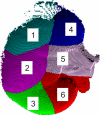Feasibility study for image-guided kidney surgery: assessment of required intraoperative surface for accurate physical to image space registrations
- PMID: 18841875
- PMCID: PMC2673657
- DOI: 10.1118/1.2969064
Feasibility study for image-guided kidney surgery: assessment of required intraoperative surface for accurate physical to image space registrations
Abstract
A notable complication of applying current image-guided surgery techniques of soft tissue to kidney resections (nephrectomies) is the limited field of view of the intraoperative kidney surface. This limited view constrains the ability to obtain a sufficiently geometrically descriptive surface for accurate surface-based registrations. The authors examined the effects of the limited view by using two orientations of a kidney phantom to model typical laparoscopic and open partial nephrectomy views. Point-based registrations, using either rigidly attached markers or anatomical landmarks as fiducials, served as initial alignments for surface-based registrations. Laser range scanner (LRS) obtained surfaces were registered to the phantom's image surface using a rigid iterative closest point algorithm. Subsets of each orientation's LRS surface were used in a robustness test to determine which parts of the surface yield the most accurate registrations. Results suggest that obtaining accurate registrations is a function of the percentage of the total surface and of geometric surface properties, such as curvature. Approximately 28% of the total surface is required regardless of the location of that surface subset. However, that percentage decreases when the surface subset contains information from opposite ends of the surface and/or unique anatomical features, such as the renal artery and vein.
Figures











References
-
- Drucker B. J., “Renal cell carcinoma: current status and future prospects,” Cancer Treat Rev. ZZZZZZ 31, 536–545 (2005). - PubMed
-
- Cookson M. S., “Radical nephrectomy,” in Glenn’s Urologic Surgery, 5th ed., edited by Graham S. D. (Lippincott-Raven, Philadelphia, 1998), pp. 61–72.
-
- Novick A. C., “Partial nephrectomy,” in Glenn’s Urologic Surgery, 5th ed., edited by Graham S. D. (Lippincott-Raven, Philadelphia, 1998), pp. 51–60.
-
- Orvieto M. et al. , “Simplifying laparoscopic partial nephrectomy: Technical considerations for reproducible outcomes,” Adult Urology 66, 976–980 (2005). - PubMed
-
- Fergany A. F., Hafez K. S., and Novick A. C., “Long-term results of nephron sparing surgery for localized renal cell carcinoma: 10-year followup,” J. Urol. (Baltimore) JOURAA 163, 442–445 (2000). - PubMed
Publication types
MeSH terms
Grants and funding
LinkOut - more resources
Full Text Sources

